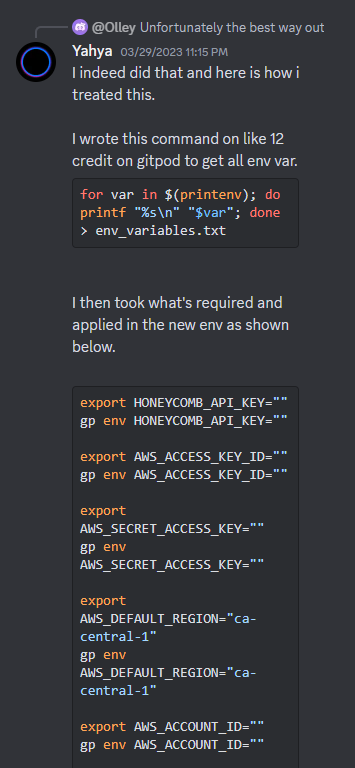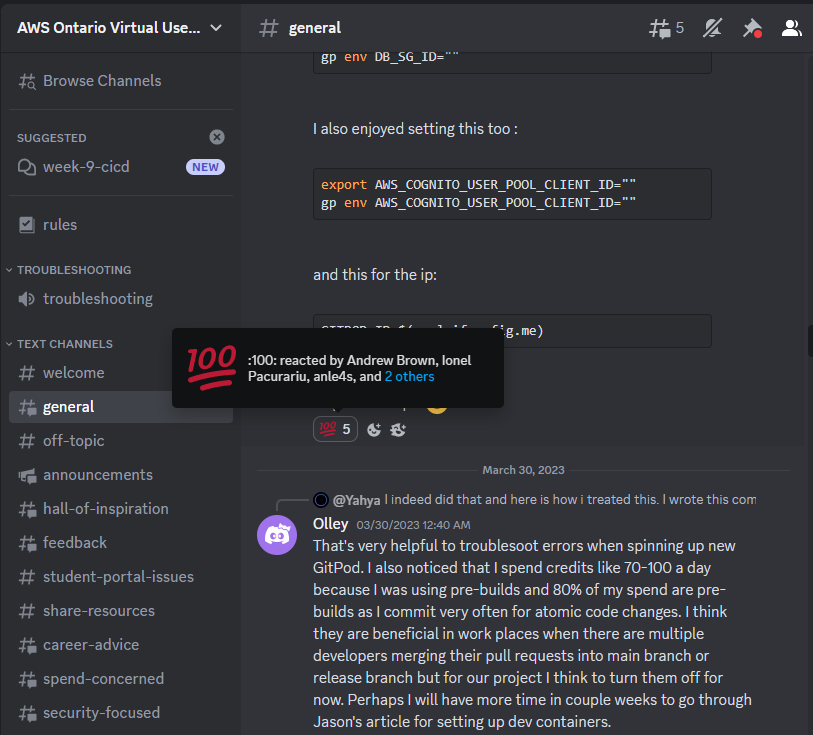A Flexible Migration Approach
This guide originated from an attempt to assist a community member with setting up environment variables in Gitpod and ultimately migrate to a new one, in case credits are over and you prefer to optimize.
The initial discussion can be found in these Discord screenshots:
View Discord Screenshot 1

View Discord Screenshot 2

When working on cloud development projects, it's crucial to be able to adapt quickly to new environments. This guide will walk you through the process of setting up essential environment variables in a fresh Gitpod workspace, ensuring you can seamlessly transition between different development environments.
Why This Matters
Flexibility in cloud development is key.
By understanding how to manage your environment variables, you'll be able to:
- Quickly set up new workspaces
- Maintain security by keeping sensitive information separate from your code
- Easily switch between different project configurations
Let's dive in!
Retrieving Your Current Environment Variables
First, let's look at how to get a snapshot of your current environment:
for var in $(printenv); do printf "%s\n" "$var"; done > env_variables.txtThis command will create a file named env_variables.txt containing all your current environment variables. It's a great starting point for identifying which variables you'll need in your new environment.
Setting Up Essential Environment Variables
Now, let's set up the core environment variables you'll need for your project. We'll use both the export command to set the variable for your current session and the gp env command to persist it across Gitpod workspace restarts.
AWS Credentials
export AWS_ACCESS_KEY_ID="your_access_key_here"
gp env AWS_ACCESS_KEY_ID="your_access_key_here"
export AWS_SECRET_ACCESS_KEY="your_secret_key_here"
gp env AWS_SECRET_ACCESS_KEY="your_secret_key_here"
export AWS_DEFAULT_REGION="ca-central-1"
gp env AWS_DEFAULT_REGION="ca-central-1"
export AWS_ACCOUNT_ID="your_account_id_here"
gp env AWS_ACCOUNT_ID="your_account_id_here"Replace your_access_key_here, your_secret_key_here, and your_account_id_here with your actual AWS credentials.
Database Connections
export CONNECTION_URL="postgresql://postgres:password@localhost:5432/cruddur"
gp env CONNECTION_URL="postgresql://postgres:password@localhost:5432/cruddur"
export PRODUCTION_URL="postgresql://root:your_password@your-db-instance.region.rds.amazonaws.com:5432/cruddur"
gp env PRODUCTION_URL="postgresql://root:your_password@your-db-instance.region.rds.amazonaws.com:5432/cruddur"Make sure to replace your_password and your-db-instance.region.rds.amazonaws.com with your actual database credentials and endpoint.
Security Groups
export DB_SG_RULE_ID="your_sg_rule_id_here"
gp env DB_SG_RULE_ID="your_sg_rule_id_here"
export DB_SG_ID="your_sg_id_here"
gp env DB_SG_ID="your_sg_id_here"Replace your_sg_rule_id_here and your_sg_id_here with your actual security group IDs.
Additional Services
For services like Honeycomb or AWS Cognito, you can add:
export HONEYCOMB_API_KEY="your_honeycomb_api_key_here"
gp env HONEYCOMB_API_KEY="your_honeycomb_api_key_here"
export AWS_COGNITO_USER_POOL_CLIENT_ID="your_cognito_client_id_here"
gp env AWS_COGNITO_USER_POOL_CLIENT_ID="your_cognito_client_id_here"Dynamic IP Address
To get your current Gitpod IP address, which can be useful for configuring security groups:
GITPOD_IP=$(curl ifconfig.me)
echo "Your current Gitpod IP is: $GITPOD_IP"Best Practices
- Security First: Never commit your
.envfile or hardcode sensitive information in your repository. - Use Gitpod's Environment Variables: The
gp envcommand ensures your variables persist across workspace restarts. - Document Your Variables: Keep a list of required environment variables in your project's README.md file (without the actual values).
- Regular Updates: Review and update your environment variables regularly, especially when switching between projects or environments.
Conclusion
By mastering the management of environment variables in Gitpod, you've taken a significant step towards more flexible and secure cloud development. Remember, the key to smooth transitions between environments is preparation and organization. Happy coding!